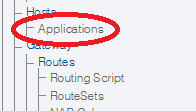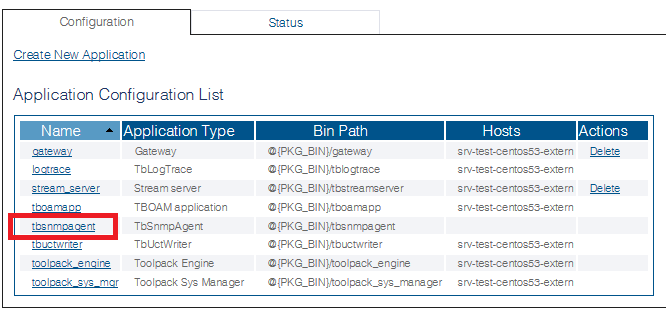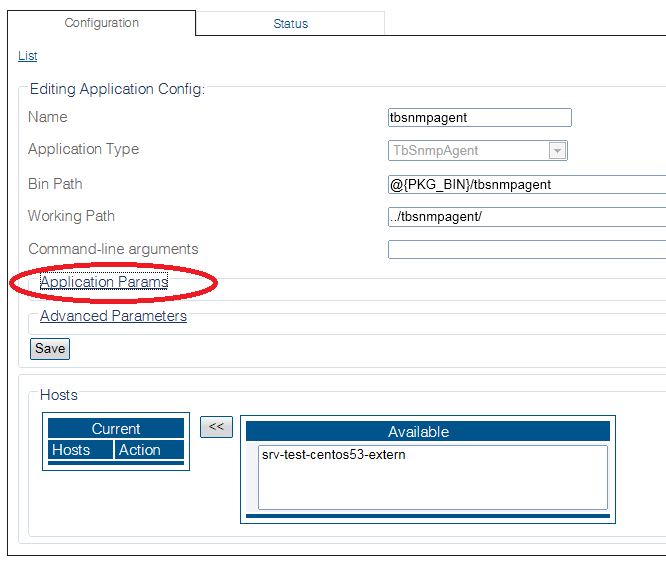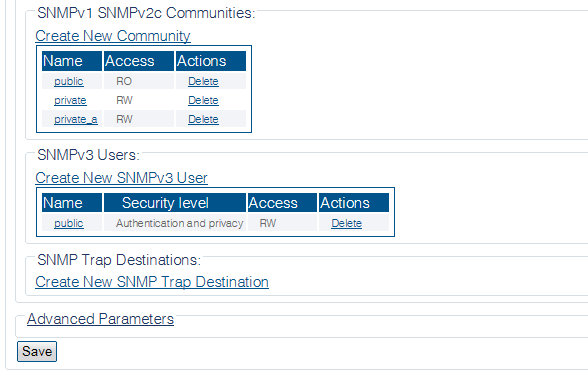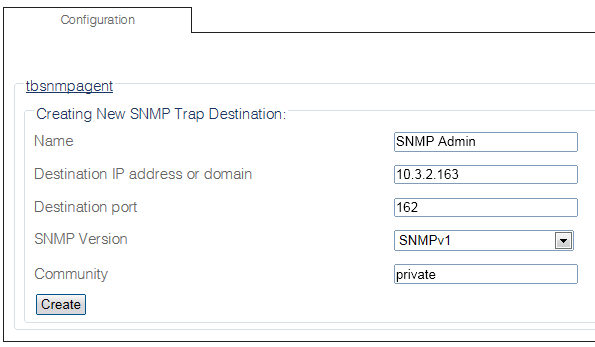Toolpack:Creating an SNMP Trap Destination B
From TBwiki
(Difference between revisions)
(new 2.8 article) |
(New article) |
||
| Line 2: | Line 2: | ||
{{DISPLAYTITLE:Creating an SNMP Trap Destination}} | {{DISPLAYTITLE:Creating an SNMP Trap Destination}} | ||
| − | |||
| − | |||
| − | |||
| − | |||
| − | |||
| − | |||
| + | SNMP traps are automatically generated on TMedia platforms by the NetSNMP installation, which monitors hardware and software interfaces registered with the ifTable of the IF-MIB module. When the operation status of an interface changes, a trap is generated by NetSNMP, and sent to a destination address for processing. In order for traps to be generated, an '''SNMP trap destination''' must be defined in the Web Portal. | ||
| + | <br/><br/> | ||
| + | To create an SNMP trap destination, do the following: | ||
| + | <br/> | ||
| + | '''NOTE:''' The procedure will vary, dependng on whether you create a trap destination for SNMPv1/v2, or for SNMPv3. | ||
| + | <br/><br/> | ||
| − | + | *Click '''Applications''' in the navigation panel. | |
| + | [[Image:Snmp_cfg_0.png]] | ||
| + | <br/><br/> | ||
| − | + | *In the '''Application Configuration List''', select '''tbsnmpagent'''. | |
| + | [[Image:Snmp_cfg_1.png]] | ||
<br/><br/> | <br/><br/> | ||
| − | + | ||
| − | + | *Click '''Application Params''' | |
| − | ''' | + | [[Image:Snmp_cfg_2.png]] |
<br/><br/> | <br/><br/> | ||
| + | |||
*Click Create New SNMP Trap Destination (under the '''SNMP Trap Destinations''' heading) | *Click Create New SNMP Trap Destination (under the '''SNMP Trap Destinations''' heading) | ||
| − | [[ | + | [[Image:Snmp_trap_0.png]] |
| − | + | <br/><br/> | |
| + | |||
| + | <u>Creating an SNMPv1/v2 Trap Destination</u> | ||
*In the trap destination configuration panel, set the following parameters '''if you are creating a trap destination for SNMPv1/v2''': | *In the trap destination configuration panel, set the following parameters '''if you are creating a trap destination for SNMPv1/v2''': | ||
**Enter a '''name''' to identify the trap destination | **Enter a '''name''' to identify the trap destination | ||
**Enter a destination '''IP Address''' for sending generated traps | **Enter a destination '''IP Address''' for sending generated traps | ||
**Enter a destination '''port number''', on which to send generated traps (standard default value is 162) | **Enter a destination '''port number''', on which to send generated traps (standard default value is 162) | ||
| − | ** | + | **Select version 1 or 2 from '''SNMP Version''' |
**Enter the name of the SNMPv1/v2 '''community''' to use (configured previously) | **Enter the name of the SNMPv1/v2 '''community''' to use (configured previously) | ||
**Click '''Create''' | **Click '''Create''' | ||
| − | [[ | + | [[Image:Snmp_Trap_1.png]] |
| − | + | <br/><br/> | |
| + | |||
| + | <u>Creating an SNMPv3 Trap Destination</u> | ||
*In the trap destination configuration panel, set the following parameters '''if you are creating a trap destination for SNMPv3''': | *In the trap destination configuration panel, set the following parameters '''if you are creating a trap destination for SNMPv3''': | ||
**Enter a '''name''' to identify the trap destination | **Enter a '''name''' to identify the trap destination | ||
**Enter a destination '''IP Address''' for sending generated traps | **Enter a destination '''IP Address''' for sending generated traps | ||
**Enter a destination '''port number''', on which to send generated traps (standard default value is 162) | **Enter a destination '''port number''', on which to send generated traps (standard default value is 162) | ||
| − | ** | + | **Select version 3 from '''SNMP Version''' |
**Enter the name of the SNMPv3 '''user''' to use (configured previously) | **Enter the name of the SNMPv3 '''user''' to use (configured previously) | ||
| − | ** | + | **Select a security level for the user from the '''security level''' drop-down box |
| − | + | **Select an appropriate '''authentication algorithm''' for the user from the '''authentication''' drop-down box | |
**Enter the appropriate authentication '''pass phrase''' for the user | **Enter the appropriate authentication '''pass phrase''' for the user | ||
| − | ** | + | **Select an appropriate '''privacy standard''' for the user from the '''privacy protocol''' drop-down box |
**Enter the appropriate authentication '''privacy phrase''' for the user | **Enter the appropriate authentication '''privacy phrase''' for the user | ||
**Click '''Create''' | **Click '''Create''' | ||
| − | [[ | + | [[Image:Snmp_Trap_2.png]] |
| − | *Verify that the '''"SNMP Trap Destination was Successfully Created"''' message | + | <br/><br/> |
| − | + | ||
| − | + | *Verify that the '''"SNMP Trap Destination was Successfully Created"''' message is displayed and that the new SNMP trap destination appears in the '''SNMP Trap Destinations''' list[[Image:Snmp_Trap_3.png]] | |
| − | [[ | + | <br/><br/> |
Revision as of 12:07, 12 September 2014
Applies to version(s): v2.8.
SNMP traps are automatically generated on TMedia platforms by the NetSNMP installation, which monitors hardware and software interfaces registered with the ifTable of the IF-MIB module. When the operation status of an interface changes, a trap is generated by NetSNMP, and sent to a destination address for processing. In order for traps to be generated, an SNMP trap destination must be defined in the Web Portal.
To create an SNMP trap destination, do the following:
NOTE: The procedure will vary, dependng on whether you create a trap destination for SNMPv1/v2, or for SNMPv3.
- Click Applications in the navigation panel.
- In the Application Configuration List, select tbsnmpagent.
- Click Application Params
- Click Create New SNMP Trap Destination (under the SNMP Trap Destinations heading)
Creating an SNMPv1/v2 Trap Destination
- In the trap destination configuration panel, set the following parameters if you are creating a trap destination for SNMPv1/v2:
- Enter a name to identify the trap destination
- Enter a destination IP Address for sending generated traps
- Enter a destination port number, on which to send generated traps (standard default value is 162)
- Select version 1 or 2 from SNMP Version
- Enter the name of the SNMPv1/v2 community to use (configured previously)
- Click Create
Creating an SNMPv3 Trap Destination
- In the trap destination configuration panel, set the following parameters if you are creating a trap destination for SNMPv3:
- Enter a name to identify the trap destination
- Enter a destination IP Address for sending generated traps
- Enter a destination port number, on which to send generated traps (standard default value is 162)
- Select version 3 from SNMP Version
- Enter the name of the SNMPv3 user to use (configured previously)
- Select a security level for the user from the security level drop-down box
- Select an appropriate authentication algorithm for the user from the authentication drop-down box
- Enter the appropriate authentication pass phrase for the user
- Select an appropriate privacy standard for the user from the privacy protocol drop-down box
- Enter the appropriate authentication privacy phrase for the user
- Click Create
- Verify that the "SNMP Trap Destination was Successfully Created" message is displayed and that the new SNMP trap destination appears in the SNMP Trap Destinations list

